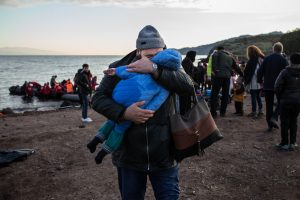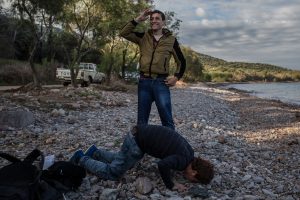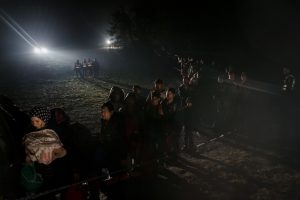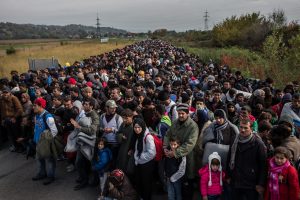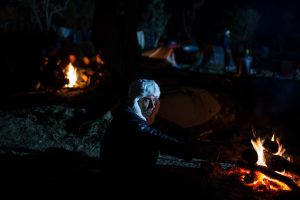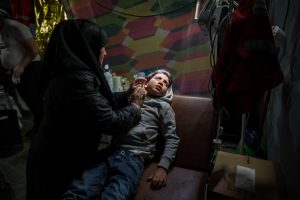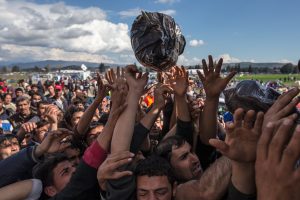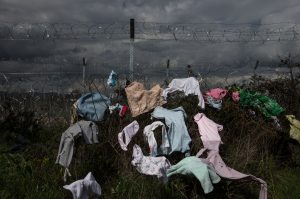

- Szír és afgán menekültek érkeznek gumicsónakon a görögországi Leszbosz szigetére 2015. december 3-án. // Most of the refugees arriving by dinghy to the Isle of Lesbos on the 3rd of December 2015 are Afghan and Syrian. Nearly 370,000 refugees and migrants have arrived in Europe this year, most of them by sea.
- Egy menekült férfi öleli át fiát, miután partra szálltak csónakjukkal Leszbosz szigetén. // A refugee man hugs his son on the Greek island of Lesbos, after crossing the Aegean sea from Turkey on the 4th of December 2015.
- A földet megcsókoló szíriai türkmén Bostan és barátja december 3-án Leszboszon, miután csónakjukkal szerencsésen partot értek. // Bostan and his friend from Syria celebrating they’re reaching Lesbos on the 3rd of December 2015 by kissing the Earth. More than 800 thousand refugees arrived in Greece in 2015.
- Több száz menekült érkezik az athéni Pireusz kikötőbe 2016 március 12-én. // Thousands of refugees arrive on a ferry from the Greek island of Lesbos at the port of Piraeus, Athens on March 12, 2016. More than 173,000 refugees came to Greece last year.
- Menekültek melegednek a tűznél a görög-macedón határon fekvő Idomeni település közelében. // Refugees gather around a fire at the Greek-Macedonian border camp near Idomeni, Greece.
- Az utolsó menekültcsoport, amelynek percekkel a teljes magyarországi műszaki határzár befejezése előtt, október 16-án sikerült átkelnie a magyar-horvát zöldhatáron Zákány közelében. // The last group of refugees was successfully crossing the green border only minutes before the complete lockdown between Hungary and Croatia near Zákány on the 16th of October 2015.
- Kerítéssel és pengésdróttal zárják le katonák a magyar-horvát zöldhatár utolsó szakaszát Zákány közelében, ahol korábban a Horvátországon át érkezők léptek be Magyarországra. // Hungarian soldiers were sealing the last section of the green border between Hungary and Croatia with ring-fenced and barbed-wire near Zakany on the 16th of October 2015. Those arriving through Croatia could earlier enter Hungary here.
- Családja és egy önkéntes ápol egy állapotos, az éjszakai tengeri átkeléstől sokkos állapotú nőt Leszbosz szigetén, november 30-án. A görög partoknál 2015-ben több, mint háromezren lelték halálukat. // After crossing the sea at night, a pregnant woman in shock is being treated by family and a volunteer in Lesbos on the 30th of November 2015. More than 1000 people died at the Greek shores last years.
- Menekültek Rigonce település közelében, Szlovéniában, októberben. Akik a horvát-szlovén zöldhatáron átjutottak, fagypont közeli hőmérsékleten, egy szabadtéri táborban töltötték az éjszakát. // Refugees near Rigonce, Slovenia in October 2015. Those crossing the green border between Croatia and Slovenia spent the night in an outdoor camp while the temperature was approaching freezing-point.
- Menekültek a szlovéniai Dobovába vezető úton a horvát határ közelében október 23-án. A szomszédos országok csak nehezen tudták kezelni a menekülthullámot a magyarországi határzárt követően. // Refugees on the road to Dobova, Slovenia near the Croatian border on the 23rd of October 2015. Following the lockdown of the Hungarian borders, neighboring countries had great difficulties managing the wave of refugees.
- Menekültek lépnek át a zöldhatáron Tovarnik település közelében, a szerb-horvát határon. // Refugees walk to cross the border from Serbia into Croatia, near Tovarnik, Croatia, September 18, 2015.
- Esküvői kép a szerbiai Berkasovo falu közelében. // A wedding picture lies in the mud after being left behind close the border with Croatia near the village of Berkasovo, Serbia.
- Magyar katonák zárják le a magyar-horvát zöldhatár utolsó szakaszát Zákány közelében. // A Hungarian soldier closes the border between Hungary and Croatia with barbed wire and a fence near Zakany.
- Menekültek szállnak le Magyarboly településnél egy horvátországi vonatról. // Refugees stand at the door of a Croatian train after arriving at a train station in Magyarboly, Hungary on the 18th of September 2015.
- Várakozás a horvát-magyar határra induló buszokra a szerb határ menti Tovarnikban. // Refugees walk to a bus to be taken to the Croatian-Hungarian border in the Serbian-Croatian border village of Tovarnik, on 19 September 2015.
- Éjszakai tűzek a Leszboszon lévő moriai menekültközpontban. // A refugee warms himself at a camp next to Moria’s processing center on the island of Lesbos, Greece. The U.N. refugee agency estimates more than 1.19 million people will need to be resettled this year.
- Leszbosz szigete, Görögország. // A woman wearing a thermal blanket provided by volunteers walks on a beach after her arrival on a dinghy, with other refugees and migrants, from the Turkish coast to the Greek island of Lesbos.
- Menekült család várja a szerbiai Berkasovo falu közelében október 20-án, hogy átmehessen Horvátországba // Refugees rest on the road near a border between Serbia and Croatia, near the village of Berkasovo, Serbia on the 20th of October 2015.
- Kerítésépítés a röszkei menekülttáborban. // Refugee camp near Roszke, Hungary.
- A röszkei menekülttáborból megszökött csoport a településtől néhány kilométerre. // Refugees on the road near Roszke, Hungary.
- A szerb-horvát zöldhatár Berkasovo közelében. // A young refugee runs through a field close to the border with Croatia near Berkasovo, Serbia.
- Elhagyott papucs Zákány közelében, miután elöző este több ezren keltek át a horvát-magyar zöldhatáron. // Slippers lie in the mud after being left behind when as thousands of refugees crossed a border from Croatia near the village of Zakany, Hungary on the 27th of September 2015.
- Átkelés a szerb-horvát zöldhatáron Berkasovo közelében. // A Refugee woman walks through a field close to the border with Croatia near Berkasovo, Serbia.
- Vasúti kocsira erősített drótkerítés a zákányi pályaudvaron. // Razor wire is carried on a train wagon to be used as border closure between Hungary and Croatia, at the railway station in Zakany.
- Menekültek a határátlépést követően Zákány közelében. // Refugees sit along a road after crossing a border from Croatia near the village of Zakany, Hungary on the 21st of September 2015.
- Menekültek alszanak a tovarniki pályaudvaron, Horvátországban. // Refugees sleep at the train station as they wait for their transit to Western Europe in Tovarnik, Croatia on the 19th of September 2015.
- Menekült asszony és beteg fia a Magyar Vöröskereszt egészségügyi sátrában a görög-macedón határ közelében fekvő Idomeni táborban. // Refugee woman and her son in medical tent of the Hungarian Red Cross at a refugee camp near the Greek village of Idomeni on the 9th of March 2016.
- Segélycsomag osztása közben megsérült férfi 2016 március 11-én az Idomeni melletti menekülttáborban. // An injured man pleads with crowds of refugees scuffling to grab aid from a truck at the refugee camp near the Greek border village of Idomeni on the 11th of March 2016. Around 50,000 migrants and refugees remain trapped in Greece after a domino of border closures by countries along the Balkan route has prevented them from continuing their journey into wealthier European countries.
- Macedón katonák zárják le a Görögországgal határos szakaszt Idomeni közelében. // Macedonian soldiers patrol behind the razor wire enforced fence on the border between Greece and Macedonia, seen from the Greek side, at the northern Greek border point of Idomeni, Greece. Barbed wire fences, tear gas, border controls, tightening of asylum laws and inadequate humanitarian aid have failed to stop the stream of people fleeing war, oppression, and poverty, and have instead created many chaotic situations on the refugee’s journey toward an improved.
- Ételosztás a görög-macedón határon. // Refugees scuffle as they reach out for food portions at the refugee camp near the Greek border villages of Idomeni on 11th of March 2016. Macedonia closed its border on 9th of March 2016. Suddenly Greece found itself with thousands of refugees at its borders, enduring wind, rain, snow and heat in the hope the border would soon re-open. Between 24 and 26 May 2016, the makeshift camp at Idomeni was eventually evacuated by the Greek police.
- A görög-macedón határ mellett letáborozott szír család várja az Idomeni határátkelő megnyitását. // Syrian family at the border fence in the refugee camp near the Greek village of Idomeni on the 11th of March 2016. Greece has made it a priority to evident migrants from the Idomeni camp and has stepped up efforts to convince them to move to nearby shelters.
- Idomeniben menekülttábor, Görögország // Idomeni Camp, Greece.
- A lezárt macedón határ Idomeni mellett. // Clothes are laid to dry on the border fence near the refugees camp at the northern Greek border point of Idomeni.
- Elhagyott épületben megszállt családok a görög-macedón határ közelében. // Refugees in an abandoned building near the Greek village of Idomeni on the 10th of March 2016.
- Az iraki Bászrából menekült Waleed Abdul Hussain a svédországi Revinge-ben, ahol a boszniai háború óta előszőr állítottak fel svéd menekülttábort 2015 decemberében. // Waleed Abdul Hussain, an Iraqi refugee from Basra sits inside a tent at the first Swedish refugee camp since the Bosnian War in Revinge, southern Sweden on the 13th of December 2015.
- Csónakokkal érkezett menekültek hátrahagyott mentőmellényei Leszbosz szigetén 2015 decemberében. A Szíriában, Irakban és Afganisztánban dúló erőszak soha nem látott mértékben növelte a menekültek számát. // Lifejackets left behind by refugees arriving at the Isle of Lesbos by boats. Numbers crossing from Turkey to Greece fell sharply after the European Union struck a deal with Ankara in March 2016 to stem the flow.

Most of the refugees arriving by dinghy to the Isle of Lesbos on the 3rd of December 2015 are Afghan and Syrian. Nearly 370,000 refugees and migrants have arrived in Europe this year, most of them by sea.

A refugee man hugs his son on the Greek island of Lesbos, after crossing the Aegean sea from Turkey on the 4th of December 2015.

Bostan and his friend from Syria celebrating they're reaching Lesbos on the 3rd of December 2015 by kissing the Earth. More than 800 thousand refugees arrived in Greece in 2015.

Thousands of refugees arrive on a ferry from the Greek island of Lesbos at the port of Piraeus, Athens on March 12, 2016. More than 173,000 refugees came to Greece last year.

Refugees gather around a fire at the Greek-Macedonian border camp near Idomeni, Greece.

The last group of refugees was successfully crossing the green border only minutes before the complete lockdown between Hungary and Croatia near Zákány on the 16th of October 2015.

Hungarian soldiers were sealing the last section of the green border between Hungary and Croatia with ring-fenced and barbed-wire near Zakany on the 16th of October 2015. Those arriving through Croatia could earlier enter Hungary here.

After crossing the sea at night, a pregnant woman in shock is being treated by family and a volunteer in Lesbos on the 30th of November 2015. More than 1000 people died at the Greek shores last years.

Refugees near Rigonce, Slovenia in October 2015. Those crossing the green border between Croatia and Slovenia spent the night in an outdoor camp while the temperature was approaching freezing-point.

Refugees on the road to Dobova, Slovenia near the Croatian border on the 23rd of October 2015. Following the lockdown of the Hungarian borders, neighboring countries had great difficulties managing the wave of refugees.

Refugees walk to cross the border from Serbia into Croatia, near Tovarnik, Croatia, September 18, 2015.

A wedding picture lies in the mud after being left behind close the border with Croatia near the village of Berkasovo, Serbia.

A Hungarian soldier closes the border between Hungary and Croatia with barbed wire and a fence near Zakany.

Refugees stand at the door of a Croatian train after arriving at a train station in Magyarboly, Hungary on the 18th of September 2015.
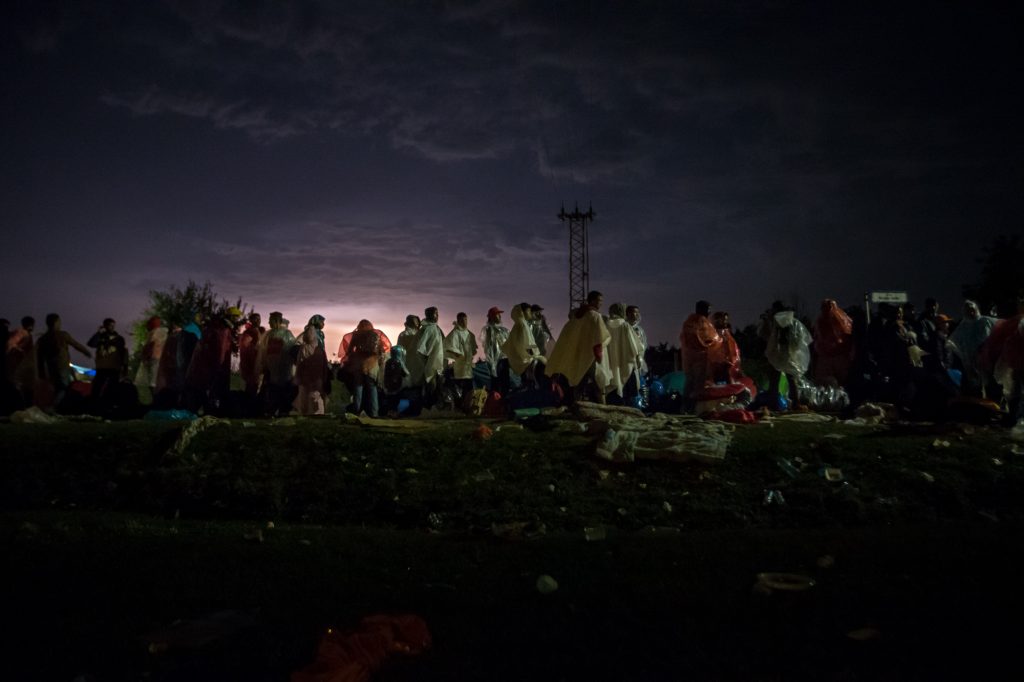
Refugees walk to a bus to be taken to the Croatian-Hungarian border in the Serbian-Croatian border village of Tovarnik, on 19 September 2015.

A refugee warms himself at a camp next to Moria's processing center on the island of Lesbos, Greece. The U.N. refugee agency estimates more than 1.19 million people will need to be resettled this year.

A woman wearing a thermal blanket provided by volunteers walks on a beach after her arrival on a dinghy, with other refugees and migrants, from the Turkish coast to the Greek island of Lesbos.

Refugees rest on the road near a border between Serbia and Croatia, near the village of Berkasovo, Serbia on the 20th of October 2015.

Refugee camp near Roszke, Hungary.

Refugees on the road near Roszke, Hungary.

A young refugee runs through a field close to the border with Croatia near Berkasovo, Serbia.

Slippers lie in the mud after being left behind when as thousands of refugees crossed a border from Croatia near the village of Zakany, Hungary on the 27th of September 2015.

A Refugee woman walks through a field close to the border with Croatia near Berkasovo, Serbia.
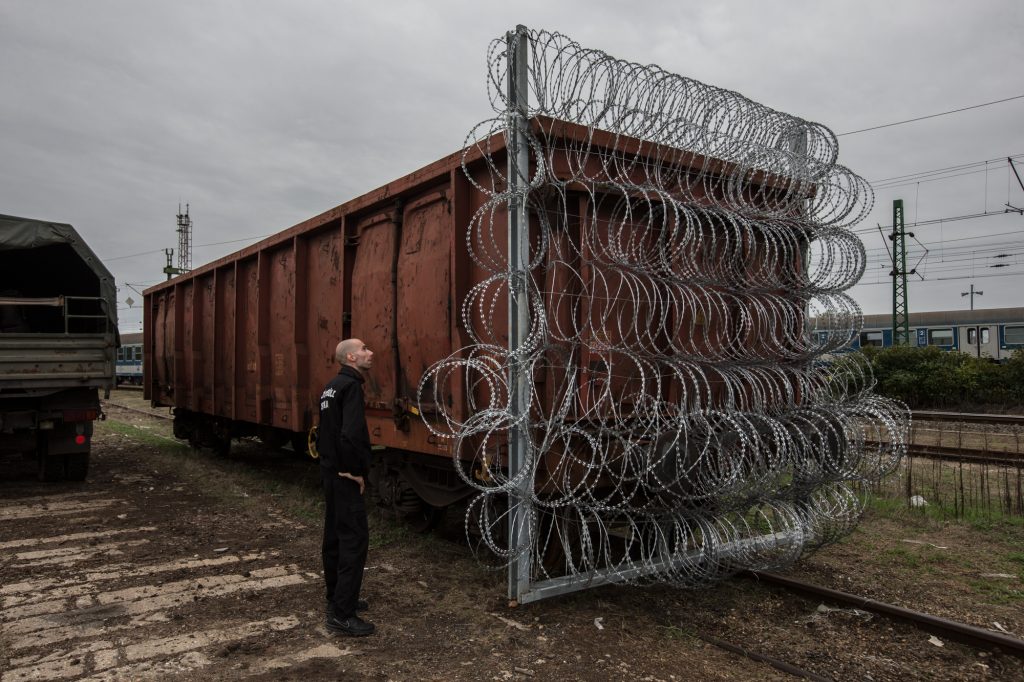
Razor wire is carried on a train wagon to be used as border closure between Hungary and Croatia, at the railway station in Zakany.

Refugees sit along a road after crossing a border from Croatia near the village of Zakany, Hungary on the 21st of September 2015.

Refugees sleep at the train station as they wait for their transit to Western Europe in Tovarnik, Croatia on the 19th of September 2015.

Refugee woman and her son in medical tent of the Hungarian Red Cross at a refugee camp near the Greek village of Idomeni on the 9th of March 2016.

An injured man pleads with crowds of refugees scuffling to grab aid from a truck at the refugee camp near the Greek border village of Idomeni on the 11th of March 2016. Around 50,000 migrants and refugees remain trapped in Greece after a domino of border closures by countries along the Balkan route has prevented them from continuing their journey into wealthier European countries.

Macedonian soldiers patrol behind the razor wire enforced fence on the border between Greece and Macedonia, seen from the Greek side, at the northern Greek border point of Idomeni, Greece. Barbed wire fences, tear gas, border controls, tightening of asylum laws and inadequate humanitarian aid have failed to stop the stream of people fleeing war, oppression, and poverty, and have instead created many chaotic situations on the refugee's journey toward an improved.

Refugees scuffle as they reach out for food portions at the refugee camp near the Greek border villages of Idomeni on 11th of March 2016. Macedonia closed its border on 9th of March 2016. Suddenly Greece found itself with thousands of refugees at its borders, enduring wind, rain, snow and heat in the hope the border would soon re-open. Between 24 and 26 May 2016, the makeshift camp at Idomeni was eventually evacuated by the Greek police.

Syrian family at the border fence in the refugee camp near the Greek village of Idomeni on the 11th of March 2016. Greece has made it a priority to evident migrants from the Idomeni camp and has stepped up efforts to convince them to move to nearby shelters.

Idomeni Camp, Greece.

Clothes are laid to dry on the border fence near the refugees camp at the northern Greek border point of Idomeni.

Refugees in an abandoned building near the Greek village of Idomeni on the 10th of March 2016.
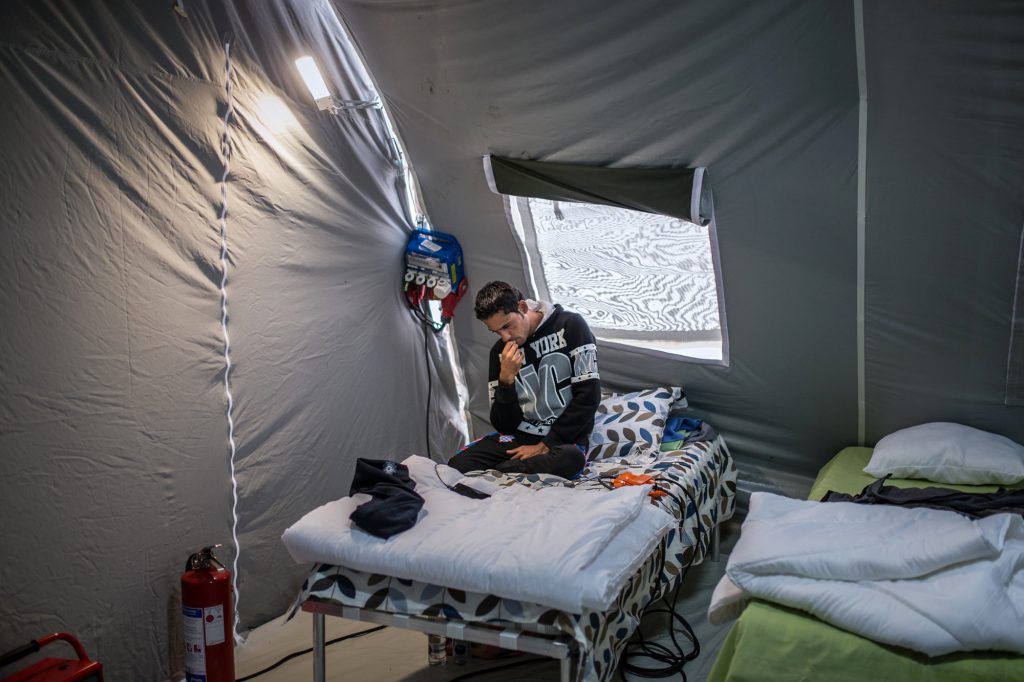
Waleed Abdul Hussain, an Iraqi refugee from Basra sits inside a tent at the first Swedish refugee camp since the Bosnian War in Revinge, southern Sweden on the 13th of December 2015.

Lifejackets left behind by refugees arriving at the Isle of Lesbos by boats. Numbers crossing from Turkey to Greece fell sharply after the European Union struck a deal with Ankara in March 2016 to stem the flow.
Closed Borders
The international refugee crisis is unique both by size and by complexity. It completely reshapes Europe and seems to be permanent.
Throughout the refugee crisis that unfolded in the spring and summer of 2015 and dominated European news headlines until well into 2016, the Balkan countries of Greece, Macedonia, Serbia, Croatia, Hungary, and Slovenia saw the most significant mass migration in Europe since the Second World War. More than a million refugees crossed the borders of the European Union in 2015 fleeing from the conflicts in Syria, Iraq and other countries. The vast majority of refugees arrived from Turkey on Greece’s eastern islands and were taken to the Greek mainland where most continued their journey independently, trying to cross the Balkans en route to Germany and other northern European countries.
In 2016, people continued to cross the eastern Mediterranean into Europe, but in much smaller numbers.
This past year has seen a tragic increase in the loss of life with a total of 5.022 dead or missing at sea, marking 2016 as the deadliest year to date. More than two-thirds of them came through Greece on their way to Western Europe. That changed in March when an agreement between the EU and Turkey transformed Greece from an entry point to a dead end.
Macedonia has closed its border on 9 March 2016 to all but a trickle of refugees and migrants, following the example of Hungary and other countries along the so-called West Balkans route to Germany. Suddenly more than 75 000 refugees and migrants are stranded in Greece and the Western Balkans.
Few years on from when the borders were sealed, refugees aren’t using South East Europe to enter the EU. The journey is more difficult, expensive and dangerous. The southern borders of both Hungary and Slovenia are completely fenced off by now. The same applies to the Turkish-Bulgarian border, part of the Bulgarian-Greek border, the Greek-Macedonian one and part of the Serbian-Bulgarian border.


